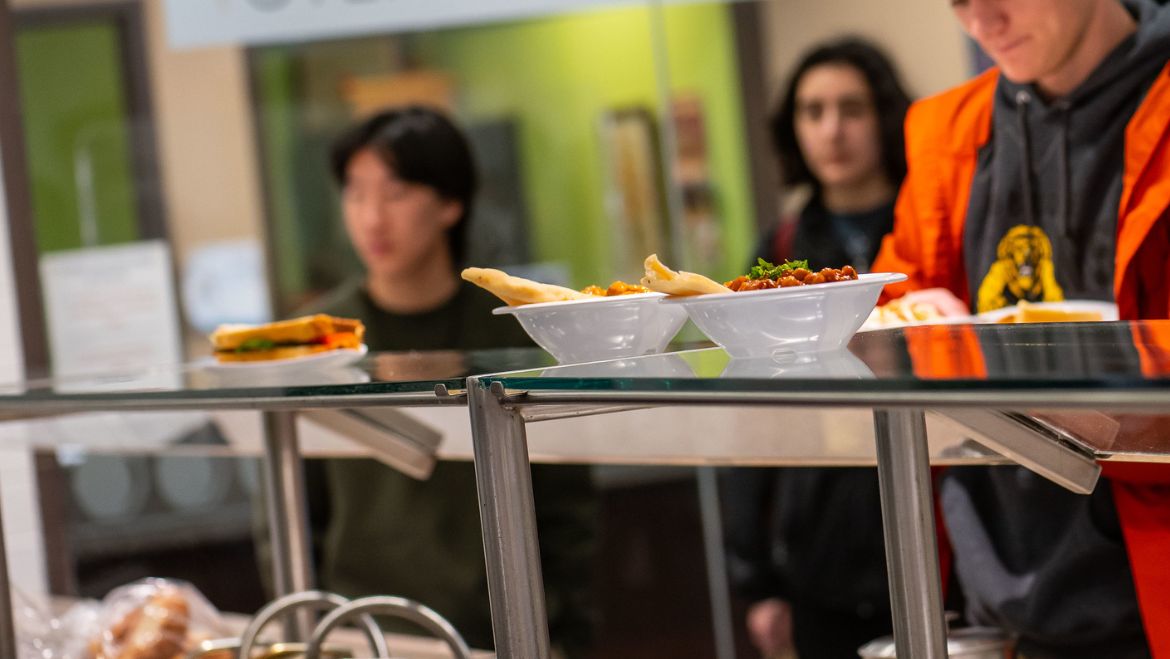

Students waiting for food at a UBC Dining Hall. Credit: Paul Joseph / UBC Brand & Marketing
How does food promote diversity and inclusivity? Food serves not only as a means of nourishment but also as a way for individuals to engage with and better understand various cultures and communities.
Food has the remarkable ability to bring people together and create a sense of connection. It offers a unique opportunity to learn about different cultures and broaden our understanding of the world. By exploring diverse cuisines, we can gain insights into various societies’ history, traditions, and social structures. For instance, analyzing the ways in which food is prepared and consumed can reveal significant information about gender roles and power dynamics in a given community.
The Faculty of Arts spoke with its faculty and staff to delve deeper into how food connects us to cultures beyond our own and helps us strengthen our identities.
Read the Q&A with Dr. Ara Norenzayan, Professor and Distinguished University Scholar at the Department of Psychology.

Dr. Norenzayan lives and works on the traditional, ancestral, and unceded territory of the xwməθkwəy̓əm (Musqueam). He is a prolific researcher and teacher in the fields of cultural evolution, social psychology, and the origins of religion. His work examines how cultural diversity shapes the human mind, and he is particularly interested in topics such as cultural and religious diversity, cooperation and conflict, the psychology of metaphysical and supernatural beliefs, human-nature interactions, sacred values, and more.
How has food and culinary arts played a role in shaping cultures?
Since ancient times, food has been a cornerstone of cultures worldwide. It is essential for our survival, which is why preoccupation with food is a human universal that connects us all. To feed our calorie-hungry big brains, our hominid ancestors invented fire and cooking, which outsourced digestion to culture. When you barbeque meat or eggplant, you make them tasty and partially digested before the food enters your mouth. This has been so important for our survival as a species that evolution has modified our bodies to have smaller teeth, weaker chewing muscles, and shorter gastrointestinal tracts than our primate relatives.
“There is more to eating than survival. Eating and drinking are a medium through which we gather, socialize, and create bonds. We celebrate, commemorate, tend to one another, and enact our rituals through food.”
In places such as Vancouver, where the food scene is so diverse, how has the globalization of food affected cultural identities and traditions?
I grew up in Beirut, Lebanon, where an amazingly rich culinary tradition that has been perfected for thousands of years taught me the love of good food. Yet, these were times when globalization had not reached the kitchen table, and I had limited exposure to the various cuisines we take for granted here in Vancouver. I had never had guacamole until I moved to North America!
I have Armenian heritage, which means that I have an arsenal of recipes passed down to me from my mother. I got my love of cooking from her. My two children have had the privilege of enjoying food from everywhere in the world. They don’t find it remarkable at all that in the same week, they could go on a worldwide culinary journey that could include sushi, samosas, tamales, and tabbouleh. Through food, they have come to learn about and celebrate the rich cultural traditions and identities that make Vancouver the wonderfully diverse city that it is.
How does the language used to describe food reflect cultural attitudes and values?
A culture’s food vocabulary is a window into its values and priorities. A typical Italian child can name twenty-two different kinds of pasta, whereas a child in Canada might know three to four different kinds. But it’s not just the vocabulary that matters; it is also the attitudes that are transmitted through language about food.
The cultural psychologist Paul Rozin has found that when French and American research participants are asked what comes to mind when thinking of fried eggs, the French say “breakfast,” Americans say “cholesterol.” The French think of the culinary experience; Americans think of what is entering the bloodstream. Interestingly, this vigilance doesn’t translate into better health. Life expectancy is, in fact, higher in France than in the United States.
How can UBC use food to promote diversity, inclusion, and understanding in our community?
When I first arrived at UBC 22 years ago, the food scene on campus was dismal. We have come a long way and there is now a wide array of eating options, but we can do better. Through food, the university can promote inclusive cultural understanding and a way of life that preserves our planet. UBC is located on traditional Musqueam lands, and there is an opportunity to celebrate the Indigenous culinary ways that have thrived on these lands for thousands of years and to this day.
Another way to do this is by establishing a sustainable food festival that brings together UBC community’s diverse constituents. Finally, we could use more public spaces to gather, eat, and drink together.
This Q&A was originally featured on the UBC Arts website. Read more Q&As with UBC Arts faculty and staff.


